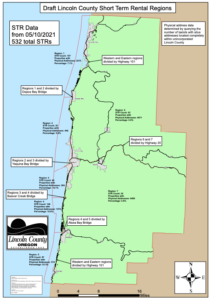By QUINTON SMITH/YachatsNews.com
Lincoln County commissioners Wednesday extended their moratorium on new vacation rental licenses for another six months and said they need to have detailed discussions on how and where to limit such rentals in five unincorporated areas west of U.S. Highway 101.
The decision comes after the Oregon Land Use Board of Appeals ruled Aug. 8 that a voter-approved ballot measure phasing out vacation rentals in unincorporated neighborhoods violated state law by retroactively banning non-conforming uses. Commissioners passed their own, less restrictive ordinance last October, but put it on hold until the state ruled on Ballot Measure 21-203.
The county Ordinance 523 and accompanying license moratorium are being challenged in Lincoln County Circuit Court by the vacation rental industry. But with the court process – and any appeals – expected to take at least a year, commissioners say they need to begin discussing and staff needs to resume work on implementing it.
The license moratorium, which has been extended at least four times over the past two years, now extends to Feb. 22. It was scheduled to expire Sept. 6.
On Wednesday, Commissioner Kaety Jacobson said the six months will give county staff and commissioners more time to work on rules, procedures and other details of the ordinance.
“There are many things that have to be worked out,” she said.

The most critical of those details, said Commissioner Doug Hunt, is revisiting limits on vacation rental licenses in five areas stretching from Lincoln City in the north to Yachats in the south. A year ago, former county counsel Wayne Belmont proposed dividing unincorporated Lincoln County into seven zones – five west of Highway 101 – and putting limits on the number of vacation rental licenses in each.
When commissioners passed their ordinance last October there were 455 licenses in the five zones west of Highway 101, according to county data. Under the previous proposal those would drop through attrition to 360.
Under last October’s formula, the number of licenses east of Highway 101 would be allowed to increase from the current 77 to 138.
The zones, the number of vacation rentals in October 2021 and under the proposed percentages are:
- Zone 5: From the north city limits of Yachats to the city of Waldport — 87 rentals which are 23.3 percent of all addresses; drops to 49 rentals at 13 percent;
- Zone 4: From the Bayshore community north of Waldport to Beaver Creek north of Seal Rock — 146 rentals, 10.6 percent of all addresses; drops to 117 rentals at 8.5 percent;
- Zone 3: From Beaver Creek to the south edge of Newport — 40 rentals, 14.1 percent of all addresses; drops to 28 rentals at 10 percent;
- Zone 2: From the north edge of Newport to the south limits of Depoe Bay — 25 rentals, 5.6 percent of all addresses; drops to 22 rentals at 5 percent;
- Zone 1: From Depoe Bay to Lincoln City — 157 rentals, 7.1 percent of all addresses; drops to 144 rentals at 6.5 percent;
- Zone 6: All the unincorporated county east of U.S. 101 from Lincoln City in the north to Highway 20 in the south — with 43 rentals, 0.9 percent of all addresses; increases to 70 at 1.5 percent;
- Zone 7: All of unincorporated county east of U.S. 101 from Highway 20 in the north to the Lane County line in the south — 34 rentals at 0.8 percent of all addresses; increases to 67 at 1.5 percent.
But Belmont or county staff never explained how they reached certain limits in each area. County staff now says the total number of rental licenses is 511, and they need to update last October’s figures.

On Wednesday, Hunt said commissioners need to get data and have extended discussions on the five areas where most of the county’s vacation rentals are concentrated. Most are developed neighborhoods, which leads to the most conflicts between residents and renters.
“The main thing that will require the most work is area caps,” said Hunt, adding that he wants to “limit the density in neighborhoods.”
The only change in the new moratorium is that the county will extend it to properties in “rural residential” zones, not just R1, R-1A and R2 zones. The sheriff’s office had been issuing a few of those the past two years, commissioners were told last week.
There were no public comments during the commission meeting Wednesday, either from the neighborhood coalition that put the phase out measure on last November’s ballot or from representatives of the vacation rental industry, who fought the ballot measure and are fighting the county’s ordinance in court.
The county, which has spent $180,000 through June on legal help to defend the ballot measure and its ordinance in court, believes it will withstand legal challenges because it is a regulation of businesses licenses, not a land-use issue — which is what tripped up the ballot measure in LUBA’s ruling.
In addition to creating the seven areas with license limits, the county’s ordinance would:
- Decrease occupancy limits three people per sleeping area plus two additional to a limit of two people per sleeping area plus two. The lower occupancy limit applies at all times and is intended to prevent large gatherings like weddings or parties at rentals;
- Tighten septic inspections and standards, which could also be used to limit occupancy but phased in to allow certified companies time to complete inspections; and
- Set up an administrative hearings process, including a contracting with a hearings officer, to handle chronic offenders cited by the sheriff’s code enforcement deputy.
- Quinton Smith is the founder and editor of YachatsNews.com and can be reached at YachatsNews@gmail.com


